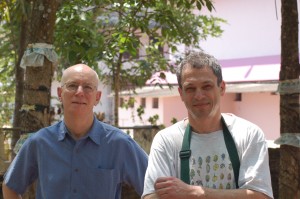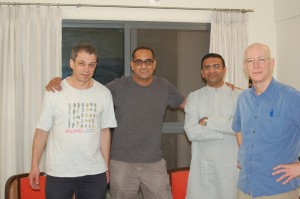I wrote about Dr István Perczel, of the Central European University in Budapest, in my post of April 9, 2012 (‘Hungarian Scholar Finds Bonanza in Kerala Archive’ – here is a link to his website ‘Project for Preserving the Manuscripts of the Syrian Christians in India’).
Recently an unexpected opportunity arose to meet István Perczel: he was in Goa with a team of archivists who are hoping to digitize Goa’s state archives. These archives have accumulated over five centuries and contain priceless materials, covering subjects that range from botany to the politics of the Mughal empire. Its earliest holdings go back to the 1490s, decades before the Mughals came to India. István describes these archives as one of the most important in the world.
Also on the team was Fr Columba Stewart, a Benedictine monk who runs the Hill Centre in Minneapolis Michigan. This library has already digitized over a hundred thousand manuscripts from church archives around the world. Among these manuscripts are many from the churches of Syria – a very fortunate thing, since some of these churches may not survive the civil war.
It was fascinating to meet these remarkable scholars and to hear of their work. Here is a picture of István Perczel (right) and Fr Columba (left);
and another of their team.
[From left to right, István Perczel, Uday Balakrishnan, Fr Ignatius Payyapilly, archivist of the Syro-Malabar Major Archbishopric in Ernakulam, and Fr Columba; pictures courtesy István Perczel].
Later István wrote:
Concerning In an Antique Land I would also like to tell how fascinating I find the two-sided description of your anthropological research: you went to Lataifah/Nashawy (or the villages indicated by these pseudonyms) to study the fellaheen and they, in exchange, were doing their own anthropological research on the doktór al-Hindi. The Syriac and Malayalam material that one can find in Kerala testifies to a similar interaction. While the Europeans arrived in India, discovered the Indians and made anthropological, geographic etc. descriptions, apparently the Indians did the same: for them this was the opportunity to discover Europe and the Europeans. Several Syrian Christian priests mounted the Portuguese ships in order to travel to Europe and see the lands there. The first one, somebody called in European sources Joseph the Indian, did so as early as in 1500. He traveled to Europe on a ship of Pedro Alvares Cabral and somewhere in Europe he was interviewed, his answers constituting the first source for the Europeans about the customs of the Indian Christians. Then he went back to his land and, apparently, became one of the staunchest opponents of Westernization and Latinization (Antony Vallavanthara, India in 1500: The Narratives of Joseph the Indian, Gorgias Press, 2010). In Cambridge, the Buchanan collection, there is a miscellaneous Indian manuscript (MS Cambridge Oo.1.29) containing an astronomical-geographical treatise written in India in Syriac, datable to the 1570s, which describes Europe giving the distances between London and Paris, Seville and Rome etc. in parasangs, the Persian measure of distance. It also describes Japan and China, clearly relying on the data received from European travelers and missionaries. The same manuscript also contains a note with a text describing the odd European habit of burning heretics (in this case, Protestants) at the stakes and ends with this sentence: “This is very hard, one feels pain even to speak about it.” Definitively, burning heretics is worse than burning the dead bodies and some sixteenth-century Indians had noticed this.
He also sent me some of his articles. They are all fascinating, because they reveal a world of fluid connections, going back many centuries, when priests traveled freely between the Malabar Coast, the Middle East and southern Europe.
Perhaps the most interesting of the articles is Classical Syriac As A Modern Lingua Franca in South India between 1600 and 2006 (Aram, 21 (2009) 289-321) which demonstrates that Syriac, an ancient language descended from Middle Aramaic, was once a link language in the Indian subcontinent (it is written in a very beautiful script, derived from Aramaic, and a precursor of Arabic).
The true revelation of the piece is that Syriac was in use in India until very recently. ‘As far as literature is concerned, we witness an incredible blossoming of Syriac literature beginning with the sixteenth century, still very vigorous in the nineteenth century and the first half of the twentieth century, declining only at the end of the same century. However, notwithstanding this decline, the latest Syriac manuscript that I have seen and photographed in Kerala is dated to 2005 and was written by Chorepiscopa Curian Kaniamparambil, the great Malankara malpan, that is, malfono – Doctor, of the Jacobite Syrian Orthodox Church, now 101, containing a devotional poem called Thousand Stanzas, a poem written in a simple and crystalline Syriac, which I find very beautiful and enjoyable, of definite literary quality. Father Curian Kaniamparampil has also rendered into verse the Gospel of St. Matthew, and has written many other works in Syriac.’ (p. 7)
Later he adds: ‘Father Kaniamparambil, now 94, learned Syriac as an autodidact when he was thirteen. Apparently he had a very great talent for this language, so much so that subsequently he began to write liturgical poetry. He also made many translations for the Jacobite West Syriac liturgy into Malayalam, used in his church…’ (19).
It strikes me as very unfortunate that this remarkable writer is so little known in India.



Hello,
Thanks for this fascinating article. I found a few sample pages of the book about ‘Joseph the Indian’ on Google Books. Thanks for sharing your random finds with readers of your blog. This book seems immensely fascinating from a cursory first glance.
This is an incredible story. You meet such interesting people. Thank you for sharing this with us. Goa’s state archives must be a treasure trove. Another Geniza!
It is just amazing to know that Syriac texts were being written in India right into the twentieth century.
wouldn’t it be wonderful if Indian archival wealth were to become available on the Internet rather than crumble in the dust.
Yes it would be wonderful – let’s hope it happens.
A
Can you post something else with this direction? I`d like to see